Canon Canon L1 and Canon L3 of 1957
A Description of two lever-wind Canon Rangefinders of 1957
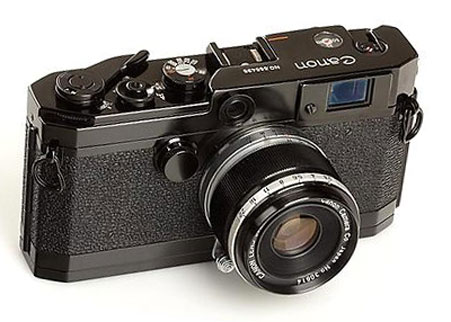
a black Canon L1 with the economy Canon 50mm f2.8 of 1957
the Canon L1 was the first Canon camera widely available in black 1
Canon L1 introduced in 1957
By 1957, the preference of active photographers for the lever-wind film advance over the trigger rapid advance, which had been promoted by Canon since 1951, was evident. Consequently, Canon launched the Canon L1 camera in February, 1957, The L1 was essentially a Canon VT with thumb lever film advance rather than trigger.
The L1 was also more economical than the VT; the L1 price equipped with a comparable lens was 75% of the VT price. Although it was advertised with the Canon 50mm f1.2 lens, which was Canon's promotion of that year, many L1's were sold with the more economical 50mm f2.8 as shown in the photo above. The 50mm f2.8 lens sold for 16,000 yen while the 50mm f1.2 cost 60,000 yen.
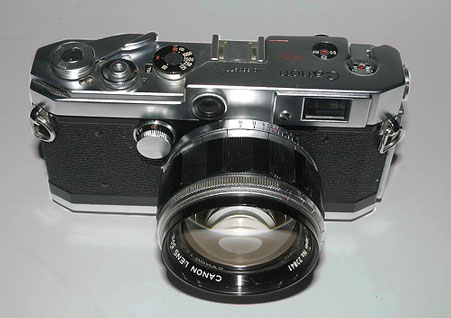
a Canon L1 with the aggressively promoted Canon 50mm F1.2 lens
Canon L1 Characteristics
Canon L1 featured a number of important innovations:
- a greatly improved three mode viewfinder, described below.
- the improved shutter mechanism of the Canon IVSB2.
- for the first time in a Canon camera, a fully opening back for film loading, rather than the more difficult bottom loading of all previous Canons.
- replacement of the Canon flash rail with a compact PC outlet, compatible with many new electronic strobe flashes, and with a surrounding bayonet lock into which a new range of Canon flash units could be attached, compactly.
- a parallax correction pin in the accessory shoe for Canon type-V accessory finders.
Canon L1 Viewfinder and Parallax Adjustment
The viewfinder of the Canon L1 featured improved brightness and lasting quality image - not the case with the later reflect viewfinder frames of the VI series Canons. The L viewfinder offered three viewing positions:
- the "35" position provided a full 35mm view, but without bright lines or parallax correction.
- the "50" postion gave a 70% of lifesize view for the 50mm lens.
- although not parallax corrected in the normal viewfinder, both the Canon VT and L2 had a new feature in the accessory shoe. A pin in the center of the accessory shoe raised and lowered according to the rangefinder focus. This pin linked to new V-type Canon accessory finders. The finders would raise and lower, moved by the pin, as the camera was focused, allowing them to correct automatically for parallax. This was an advanced feature unique to Canon.

the parallax adjustment pin located in the accessory shoe which links to the matching pin in the bottom of the Canon V-type accessory finder

two Canon V-type adjustable finders: 28mm and 100mm showing pivoting base which slides into the accessory shoe,
with arrows pointing to parallax adjustment pins which link to the corresponding pin in the accessory shoe
Canon L1 Flash Synchronization
The Canon L1 had a new compact PC replacing the synchronization bar of previous synchronized Canons. The camera featured a new compact PC outlet, compatible with many new electronic strobe flashes, and with a surrounding bayonet lock into which a new range of Canon flash units could be attached, compactly. The flash connection was a marked improvement over the large flash rail of previous synchronized Canons.
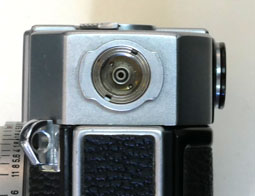
Canon bayonet flash PC outlet with locking collar
Canon L1 Flash Selection
The Canon L1 synchronized for both flash bulb and electronic strobe flash. The selection between these was performed by moving a small lever located next to the high speed shutter dial.
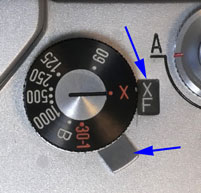
the small flash selector switch and the window showing which synchronization
in this case, electronic strobe flash - XF - has been selected
The Canon L3 Economical Model
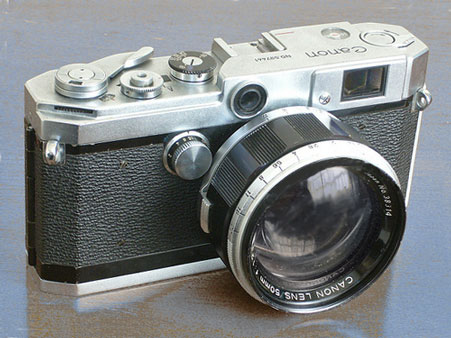
Canon L3 of 1957 with the less characteristically mounted 50mm f1.2 lens
Characteristics of the Canon L3 of 1957
Contrasting with the other Canon cameras of 1957, the Canon L3 was intended to be of low price and attractive to the beginning or casual photographer. It lacked the (now usual) 1/1000 second top shutter speed, and it was the last Canon camera to lack flash synchronization.
While the Canon VT sold for 82,000 yen with a Canon 50mm f1.8 lens, the Canon L3 sold for only 48,000 yen with a Canon 50mm f2.8 lens. The Canon L3 was less than half the retail selling price of the L1 with the same lens. The de-featuring of the Canon L3 of the top speed and of flash synchronization was a marketing decision, since internally it was the same as the other Canon models of that year. The L3 seems to have sold primarily in the domestic Japanese market. Peter Dechert estimates that the Canon L3 sold 12,975 units, more than the 7,350 L1 units, and nearly as many as the 15,575 Canon VT.

as can be seen on the Canon L3 top, it lacks 1/1000 second speed and does not have flash synchronization; the flash synchronization window is blacked-out
the pop-up film rewind knob is identical to Canon VT.
A number of Canon lenses were introduced in 1957, including the 35mm f2.8 made in a new light-weight alloy mount with black focusing ring. This was an ideal lens for the Canon L3 since is was low in price (19,500 Yen) and worked well with the 35mm image size of the L3 viewfinder.
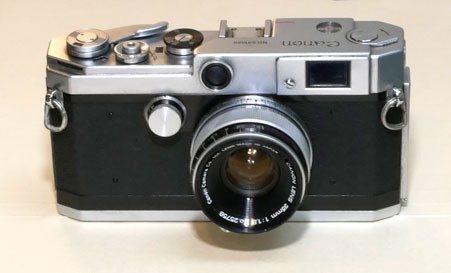
a Canon L3 of 1957 with the black Canon 35mm f2.8 in new light-weight alloy mount
You can click on the links in the table below to consult other pages of the canonrangfinder.org site.
| Navigation: Click Below to Jump to Desired Subject Page | ||
|---|---|---|
| Canon Rangefinder Cameras - 1 | Canon Rangefinder Cameras - 2 | Canon Rangefinder Lenses |
| Canon S | Canon IVSB2 | Canon 19mm |
| Canon J | Canon IIS2, IID2, IIF2 | Canon 25mm |
| Canon NS | Canon VT, Canon L2 | Canon 28mm |
| Canon JS | Canon L1, L3 | Canon 35mm |
| Canon J-II | Canon VT Deluxe | Nikkor 50mm |
| Canon S-II | Canon VL, VL2 | Canon 50mm |
| Canon IIB | Canon VI-L, VI-T | Canon 85mm |
| Canon III, IIC, IV | Canon P | Canon 100mm |
| Canon IIIA, IVF, IVS | Canon 7 | Canon 135mm |
| Canon IIA, IID, IID1 | Canon 7s | Canon 200mm-1000mm |
| Canon IVSB | Minolta Rangefinders | Minolta Lenses |
| Canon IIF, IIS | Other Rangefinders | other M39 lenses |
| Go to canonrangefinder.com home page | ||
Any additions or corrections to these pages would be welcome simply by contacting this site as shown at the foot of this page .
Footnotes:
1 Dechert, Peter. Canon Rangefinder Cameras 1933-1968. Hove Collectors Books. West Sussex, United Kingdom. 1985. ISBN 0-906447-30-5.
Peter Dechert's book is the most important expert source of information regarding Canon Rangefinder Cameras.
2 Kitchingman, Peter. Canon M39 Rangefinder Lenses 1939-1971. A Collector's Guide. Published by Peter Kitchingman. Perth, Australia. 2008. ISBN 978-0-646-48144-9.
Peter Kitchingman's book is the definitive study of the more than three decades of M39 format camera lenses developed for Canon Rangefinder Cameras.
3 Nostalgic Canon Camera Book. 懐かしいキヤノン EI Publishing Co. Ltd. Tokyo, Japan. June 2003.
Peter Kitchingman's book is the definitive study of the more than three decades of M39 format camera lenses developed for Canon Rangefinder Cameras.
4 "Canon Camera Museum" history website. https://global.canon/en/c-museum/history/ published by Canon, Inc. accessed in 2019.
5 Rajner, Hans P. (author), John Wade (editor). Leica Copies. Classic Collections Publications. London, UK. ISBN 13: 9781874485056
Hans P. Rajner's book is an excellently detailed and carefully researched study of camera from around the world which used the Leica M39 lens mount and the same lens to film plane distance.
7 Dechert, Peter. Canon Single Lens Reflex Cameras 1959-1991. Historical Camera Publications. Yakima, Washington. 1992. ISBN 1-879561-04-2.
8 Tomlinson, Shawn M. The Film Photography Book. Lulu Pulbications. 2016. ISBN: 9781365263972
9 Sartorius., Ghester. Identifying Leica Lenses. Classic Camera 19. Tokyo, Japan. 2001. ISBN 4-257-12029-0
10 website http://www.nicovandijk.net/rflensmatrix.htm consulted 2019.
11 O'Reagan, Douglas M. Allied Exploitation of German Science after World War II. Johns Hopkins University Press. Baltimore, Maryland. 2019. ISBN 9781421428888
12 website www.canonrangefinder.servehttp.com consulted 2008.
13 Minolta expert Andrea Aprà has posted information on minoltarangefinders group and other groups and further detailed information by email. (thanks Andrea !)
14 website http://www.collection-appareils.fr/objectifs/ consulted 2019.
15 Small, Marc James. Non-Leitz Leica Thread-Mount Lenses. Wittig Books. Hückelhoven, Germany. 1997. ISBN 3-930359-47-2.
16 the Nikon Corporation website: https://imaging.nikon.com/history/ consulted 2019.
17 p 152. Ray, Sidney F. Photographic Lens ISBN 9780240510323
18 website http://www.rokkorfiles.com/Lens%20History.html accessed 2019
If you have any comments or questions about this Leopold Stokowski site, please e-mail me (Larry Huffman) at e-mail address: [email protected]